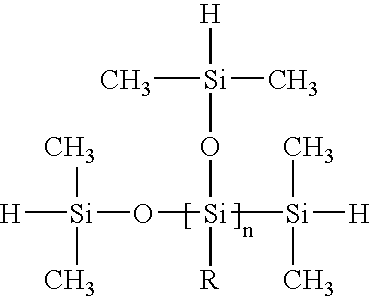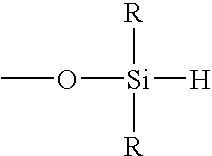Curing rubber by hydrosilation
a technology of hydrosilation and rubber, applied in the field of thermoplastic vulcanizates, can solve the problems of limited availability of diene-containing rubbers that include desirable unhindered carbon-carbon double bonds, ineffective use of crosslinking agents, and inability to cure sterically hindered vinyl groups
- Summary
- Abstract
- Description
- Claims
- Application Information
AI Technical Summary
Benefits of technology
Problems solved by technology
Method used
Image
Examples
examples
[0095]Throughout the examples, several hydrosilating agents were employed and compared for their effectiveness for either thermoplastic vulcanizate or thermoset systems. These hydrosilating agents include the following.
[0096]Hydrosilating Agent I was a hydride-modified silica Q resin that was obtained under the tradename HQM 107™ (Gelest, Inc.). This hydrosilating agent was characterized by a molecular weight of about 900 g / mole and an activity of about 8-9 equivalents / kg, and included at least 3 silicon hydride groups that are spatially separated by at least 6 atoms.
[0097]Hydrosilating Agent II was a methylhydrosiloxane-octylmethylsiloxane copolymer hydrosilating agent obtained under the tradename DC2-5084™ (Dow Corning), and was characterized by a molecular weight of 1,800 g / mole and an activity of 7.2 equivalents / kg, and included at least 3 silicon hydride groups, but they were not spatially separated by at least 6 atoms.
[0098]Hydrosilating agent III was a difunctional hydride te...
embodiment 1
2. The method of embodiment 1, where each R is independently selected from an alkyl group.
3. The method of embodiment 1 or 2, where the hydrosilating agent is defined by the formula
[0139]
where each R is independently a monovalent organic group, where α is a moiety containing a sufficient number of atoms to allow at least 2 of the SiH-containing groups to be spatially separated by at least 6 atoms, and x is an integer of at least 3.
4. The method of any of the preceding embodiments, where the hydrosilating agent includes at least 3 substituents defined by the formula
[0140]
where each R is independently a monovalent organic group or hydrogen and each R2 is independently a monovalent organic group or a silicon-containing moiety.
5. The method of any of the preceding embodiments, where the hydrosilating agent includes a substituent defined by the formula
[0141]
6. The method of any of the preceding embodiments, where the hydrosilating agent includes less than 20% of its silicon atoms positio...
embodiment 2
7. The method of numbered embodiment 2, where the hydrosilating agent is substantially devoid of silicon atoms positioned in groups defined by the formulae
[0143]
where each R1 independently includes a monovalent organic group or hydrogen.
PUM
| Property | Measurement | Unit |
|---|---|---|
| Tg | aaaaa | aaaaa |
| Tg | aaaaa | aaaaa |
| density | aaaaa | aaaaa |
Abstract
Description
Claims
Application Information
 Login to View More
Login to View More - R&D
- Intellectual Property
- Life Sciences
- Materials
- Tech Scout
- Unparalleled Data Quality
- Higher Quality Content
- 60% Fewer Hallucinations
Browse by: Latest US Patents, China's latest patents, Technical Efficacy Thesaurus, Application Domain, Technology Topic, Popular Technical Reports.
© 2025 PatSnap. All rights reserved.Legal|Privacy policy|Modern Slavery Act Transparency Statement|Sitemap|About US| Contact US: help@patsnap.com



